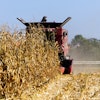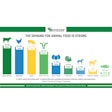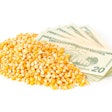
Chalk it up to good intentions that had unintended consequences. The business tax provisions of the Tax Cuts and Jobs Act enacted Dec. 23 contained a provision designed to provide relief to taxpayers other than corporations but inadvertently created a massive advantage for farmers doing business with farmer-owned cooperatives.
Section 199A of the law allows growers of a wide range of agricultural products to enjoy a tax reduction of:
- 20% of gross sales of commodities sold to co-ops or
- 20% of net income sold to corporate grain operations and independents.
For example, if Farmer A sells $100,000 in grain to a co-op, he can deduct $20,000 from his taxes because the law allows a 20% tax reduction on gross sales.
However, if Farmer B sells $100,000 in grain to a private grain operator and his net income that year is $8,000, his tax deduction is limited to just 20% of that amount or $1,600.
Some analysts have noted the advantage is significant enough that farmers who sell grain directly to co-ops could eliminate their entire tax bills.
The provision found its way into the bill in the final hours of deliberation to compensate co-ops and grain producers when Section 199 of the U.S. Tax Code was eliminated. Cooperatives and their farmer-patrons had enjoyed the perk since 2004.
Farmer-owned cooperatives that pass through income as dividends also would benefit from the new tax law. It would allow farmers to not only take advantage of a 20% deduction on income available to every business entity, but they also get to deduct 20% of their “qualified cooperative dividends” in an amount up to their total taxable income without capital gains. It is a provision that applies to any farmer-owned cooperative, not just those processing grain.
Based on some analysts’ predictions, the new deduction equates to between 5 cents to 20 cents or more per bushel on grain sales, says Randy Gordon, president and chief executive officer of the National Grain and Feed Association (NGFA).
“We have already encountered situations in which companies lost grain sales thanks to the falling value of the dollar on international markets and an increase in prices caused by weather-related problems in Argentina,” he explained. “Market spikes caused renewed interest in exports and generated forward contracts. However, Section 199A provided a strong tax code-based incentive to sell to co-op businesses instead of private grain operations.”
Gordon was quick to note that NGFA did not lobby for deleting the old Section 199 or for its replacement with Section 199A. Nor were most agricultural organizations, including NGFA, given notice the provision was included in the tax bill.
As occurs in the final stages of many bills, Section 199A was hastily drafted and attached to the measure in the waning hours of the tax bill’s consideration to secure support from legislators. When the dust settled, privately-owned agribusinesses were stunned by the provision.
The windfall tax advantage for producers who elect to sell agriculture products only to cooperatives created a significant incentive for farmers to shun independent, privately-owned operations, including small grain elevators.
That resulted in some private, independent agribusinesses to consider reorganizing their enterprises as cooperatives, while others postponed scheduled investments to expand or improve their facilities to better serve their farmer customers. Industry officials also expressed concern that Section 199A could spark further consolidation within the agribusiness sector, ultimately leaving farmers with fewer choices when market ing their products or when buying crop and other farm inputs. When the unforeseen impact of the 199A provision was uncovered, legislators in grain belt states, including the authors of Section 199A began working to rectify the problem, says Gordon.
Unintended consequences
Legislators who signed onto the tax law were quick to see the error of the 199A provision and the way it particularly impacted grain operators.
Senator Chuck Grassley (R-Iowa), who serves on the Senate Finance and Agriculture Committees, noted, “It is pretty simple that Congress would not pass a law that would put some segments of our economy out of business, and that is why it needs to be changed.”
House Ways and Means Committee Chairman Kevin Brady (R-Texas), whose committee has jurisdiction over tax issues in the House, signaled his willingness to develop a solution “that’s thoughtful, carefully crafted and effective in restoring balanced competition in the marketplace.”
Senate Finance Committee Chairman Orin Hatch (R-Utah), whose committee has jurisdiction over tax policy in the Senate, admitted that Section 199A ended the competitive balance that existed between co-ops, private companies and the farmers who sell crops to both types of businesses. He says he is “committed to developing a solution to this issue that does not choose winners and losers, and is fair to everyone involved.”
The discrepancy even caused U.S. Department of Agriculture Undersecretary Greg Ibach to proclaim, “The federal tax code should not pick winners and losers in the marketplace. We applaud Congress for acknowledging and moving to correct the disparity, and we expect that a solution is forthcoming.”
In fact, the discrepancy was so disparaging that 86 Republican members of the House of Representatives in late February sent a letter to congressional leaders expressing their concerns that a solution is immediately implemented and retroactively applied to restore the competitive marketplace.
“We are concerned this provision unfairly distorts the marketplace with the potential to reduce competition, directly harm small and independent businesses and increase consolidation in the agricultural industry,” the letter read.
Crafting a remedy
The fix is not as easy as it would appear to be. Gordon says the challenge has been to replicate the benefits that cooperatives and their farmer-patrons received under Section 199 as it existed in December, while also restoring the competitive landscape of the marketplace that existed before enactment of Section 199A — all while drafting language in a way that fits within the construct of the new tax law.
Two principal organizations approached Congress to advise in developing an equitable solution to correct the problem. They include NGFA, whose members consist of farmer-owned cooperatives and corporately-structured grain handlers and processors, as well as the National Council of Farmer Cooperatives.
Consistent with the direction of Congress, the groups are seeking to replicate the tax benefits previously available to co-ops before the passage of the tax cut bill. However, wish to do so in a way that does not influence a farmer’s marketing decisions to favor one type of business entity over another solely to gain a tax advantage.
Gordon says NGFA had been involved in discussions for the past two months meeting with co-op executives and tax experts from both cooperative and private/independent companies to hammer out a solution.
“We have received some fantastic expert advice from all the impacted parties — private and independent companies, co-ops and people specializing in tax policy,” he explained. “They have helped us walk through the issues and analyze various proposals designed to be equitable to all parties, including producers.”
Gordon noted in an interview in early March that the tax committees of Congress now are finalizing a legislative proposal to correct the problem and plan to include it as part of the fiscal year omnibus appropriations bill that Congress is required to enact by March 23 to keep the federal government operating. He expressed confidence that this goal will be met and says indications currently are that the solution will be retroactive to Jan. 1, the start of the 2018 tax year.
In a January 12 Reuters arti cle, writer Tom Polansek noted, “If legislators do not address the provision by the autumn harvest, private grain companies could lose out on deals to buy billions of bushels of corn and soybeans. Farmers already are looking at how they can transfer grain stored at private elevators to co-ops to take advantage of the new law.”
Will Congress act?
With control of both houses up for grabs in November, the opportunity to get significant work done as the election nears becomes more precarious. It is because control of Congress is at stake that many believe legislators will work together to resolve Section 199A flaws, so it does not become a campaign issue.
Secretary of Agriculture Sonny Perdue, during an address in early March at the Commodity Classic event involving corn, soybean, wheat, sorghum and other producer organizations in Anaheim, CA, also says he believed a solution was near and that USDA was supportive of Congress correcting the disparity in the marketplace created by Section 199A. He, too, says he thought the legislative solution would be retroactive to Jan. 1.
Many people share the optimism expressed by Sen. Mike Rounds (R-S.D.) who noted, “The inclusion of Section 199A in the tax law was always to maintain the status quo for the agricultural sector. It has come to our attention that some producers are concerned that the law, as written in the new tax code, gives an unfair advantage to cooperatives over independent operators.
“This was never the intent, and I am pleased there is widespread support among producers and Congress to address this concern,” he added. “We have been working with our colleagues and stakeholders from both sides on a legislative fix. Those conversations have been productive, and we look forward to finding a solution in a timely manner.”
Meanwhile, NGFA’s Gordon and Chuck Conner, president and CEO of the National Council of Farmer Cooperatives, have said the marketplace dislocation caused by Section 199A is “unsustainable,” and the two organizations continue to work to enact a solution that can be included in the next available legislative vehicle headed to President Trump’s desk.


















